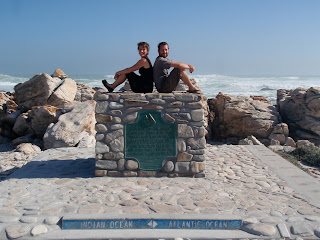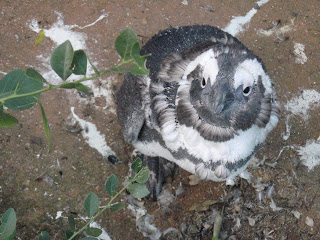So during our visit in the Garden Route we decided to try out the Harkerville Trail...
The first 10 km or so is through lovely rambling forest. Most of it seems indigenous, but a few times you pass through pine plantations. Here we came across a little (figuratively only) reminder of our former home, an experimental plot of California Coastal Redwoods!

I took way too many photos and it was a challenge to distill them. But let's jump ahead in time. We hiked a few hours through this lovely forest and finally emerged into daylight as we reached the sea at a fine lookout point. We inched our way down a very steep path to a rocky beach. Knowing that we only had 4km or so to our hut, we had a leisurely lunch and a nap. From the beach we saw interlocking acrobatic birds tumbling out of the sky. And we saw our first baboons scrambling down the facing hillside! They appeared like a blanket of tiny cousins sweeping across the landscape, making what we knew to be almost-impassable terrain look like a cricket grounds!
At 4pm we started hiking again and quickly discovered that our nap shouldn't have been so leisurely, as the trail became extremely rugged. We were scrambling over massive rocks and shimmying around precipices and clinging to chains with the foaming sea beneath our boots. Here are a few images from that endless and breathtaking section:



Look carefully at the following photo. Go on, click on it! Those are baboons using the trail ahead of us! Are they shy? Are they aggressive? Can they smell our snacks? We don't know, and it makes us nervous.

I love how all along the southern coast it looks like Africa is thrust out and crumbling into the sea.

Here is the Sinclair hut, which we shared with a lovely Danish couple. We were relieved to arrive before sunset.

Day Two started at the hut, high above the sea. And then at the first river mouth we plunged right back down to that crunchy coast.

Evidence of baboons ahead of us. We often see baboon poo in very scenic spots. We imagine if we were free to poop wherever we pleased, it would also end up at the viewpoints where we linger.

Not far past this poo we crossed a narrow path between the bushes and the sea. We enjoyed the displeasure of being barked at by baboons of an unknown size and temperament. Are they saying hello? Are the sounding the kill call? Or is it the maim-and-rob call? We never found out.
Not pictured: Shark frenzy and pools of acid five meters below my feet:

Not pictured: Deranged crocodiles and angry puffadders fighting among the deadly poisonous anemones:

After narrowly escaping all the aforementioned would-be buzzkillers we at last came to the beach at the far end of which ascended our insanely steep climb to the upper regions. That beach was not all peaches and gravy, however. It was more like a mile-long field of bowling balls. Here we see Wendy mediating on the afternoon's ordeals, and on her sandwich.

Up we go:

Back into a few hours of foresty decompression.




































